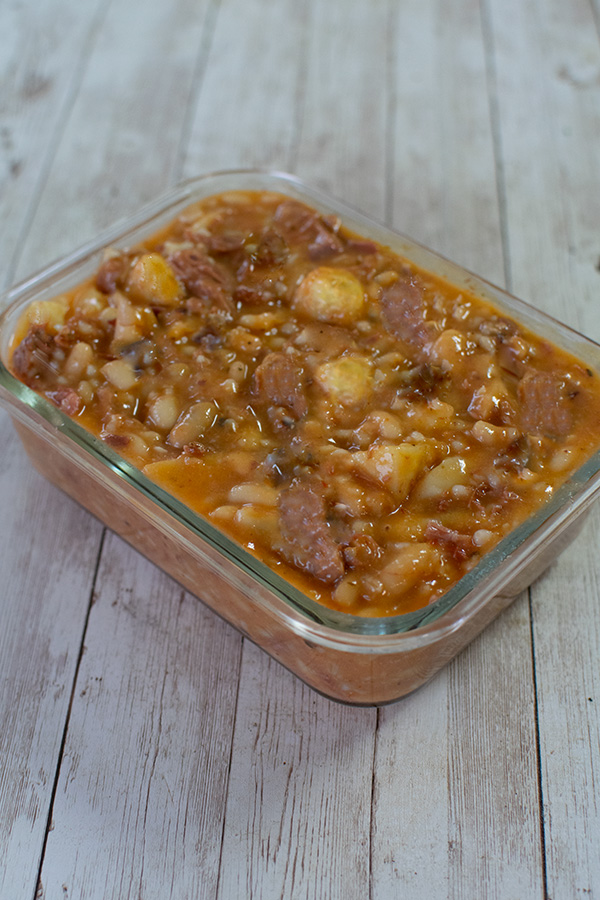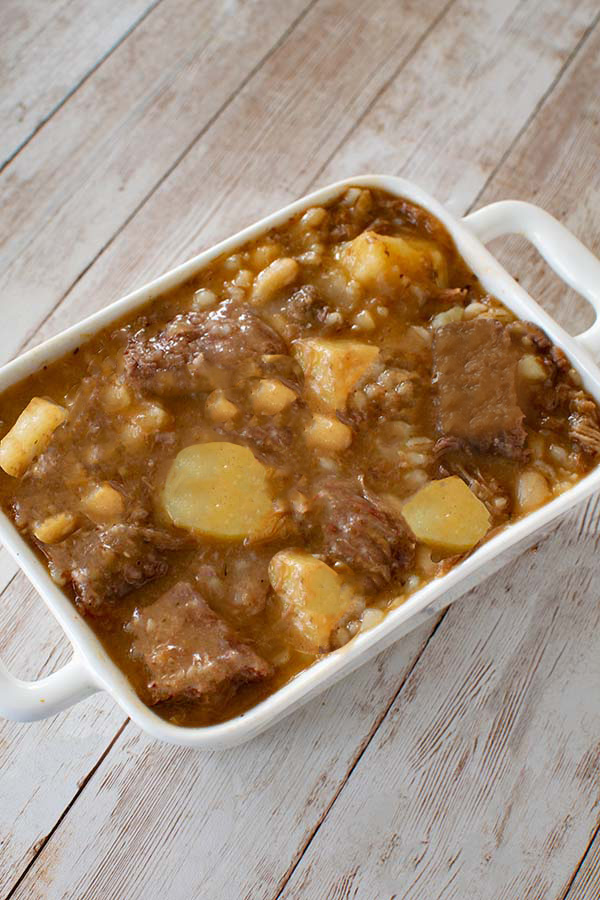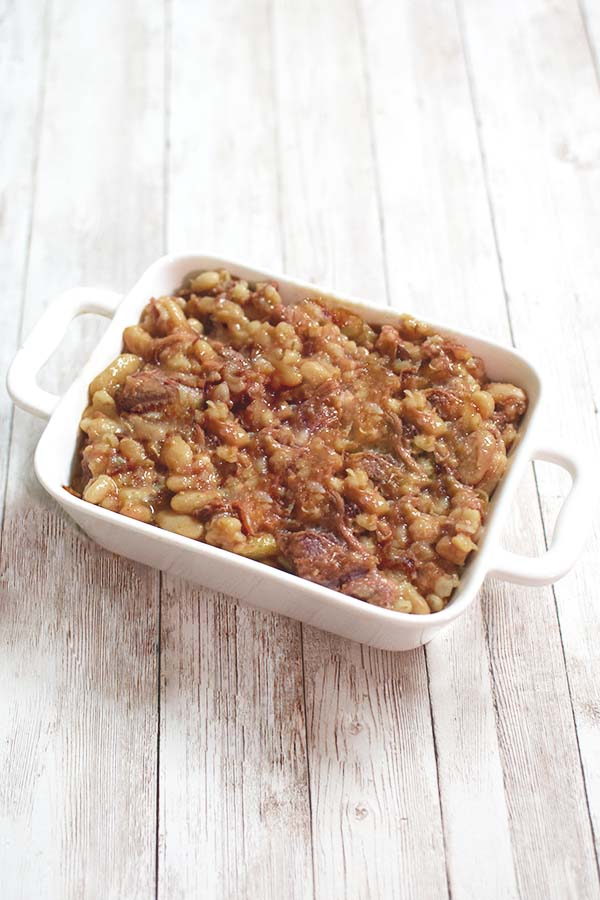This Best Cholent Recipe is an easy, one-pot recipe for classic cholent, the Jewish Sabbath stew, made of meat, beans, barley, and potatoes.

Cholent is a favorite dish left to stew overnight on Sabbath and eaten for lunch. Everyone has their own way of making it to their own taste and, in Israel, cultures take inspiration from one another.
I like to keep mine to the classic and basic, 4 ingredients and flavor.
I have seen some cholent recipes that call for a myriad of ingredients—a teaspoon of this or that—as if they are essential to making cholent.
They’re not.
It’s all just a matter of personal preference and you can add into yours whatever you like!

A little of my cooking background
I really wanted to title this blog “If I can make it, anyone can” because, honestly, if I can make it, anyone can.
I never really liked cooking, and when I was single, a meal for me meant grilled cheese, eggs, tuna, or something else that didn’t require effort or time.
When my kids were young, I was still able to get away with preparing only a small variety of easy meals, but the older they got, the more dishes I learned to make at their request.
Still, I insisted on keeping it simple.
Honestly, I never understood why some cooks unnecessarily complicate meals. I have seen recipes that have several ingredients that don’t really seem to add much, if anything, to the dish. So, why bother?
It has always been important to me that whoever eats at my table will have plenty to enjoy, and that includes my kids (I never agreed with the “You will eat what is served, or you won’t eat” ideology), and, because I keep it simple, I can prepare a variety of dishes in a relatively short period of time.
I have a philosophy regarding being a great cook: Prepare food according to the tastes of those who will be eating it, and they will love your cooking!
As far as I am concerned, start with the basic ingredients that make the dish what it is, adapt according to taste, and voila! You are an amazing cook!
The bottom line is that while there are certainly delicate recipes out there for specialty dishes, making delicious meals doesn’t have to be complicated or time-consuming. It’s not difficult to impress—just make sure it tastes good.
While some of the recipes on my blog are more time-consuming than others, they are all tried and true, easy-shmeezy!
Of course, one always has to consider the conditions under which they cook. Weather (humidity, heat, cold), different types of ovens, different qualities of pots, etc.—all of which can affect your cooking and baking.
Nevertheless, as I said, if I can do it, anyone can!
Everyday pantry essentials (suggested)
As I learned to prepare more and more recipes, I also learned which basics and seasonings are good to have on hand to have the ability to make a dish on short notice and not have to run out to the store or borrow from a neighbor.
While I will admit that I am not always prepared when one of my kids asks for eggplant parmesan or lasagna at the drop of a hat (which they have done), I dislike having to postpone making something just because the ingredients needed to make a reasonable meal were not readily available.
So, I maintain a selection of what I consider “pantry essentials” in my refrigerator and on my shelves at all times.
Initially, many of the herbs and spices were useful to me only on occasion (having been purchased for a particular recipe), and I usually just had them around as leftovers. However, as I began to cook more of a variety, I was really glad to have them (hey, look, I already have that!). And that is how my list began.
While, of course, most of the essentials will not be needed just for any one recipe, at least some of them are needed for most recipes, and you would be surprised how many recipes can be made just with this list. So, if you keep whatever you use regularly on hand, it can really save you time and effort.
Everyone has their favorite recipes, preferred seasonings, and just whatever they like to use to cook. Your own list should certainly reflect your own cooking tastes and style.
Just to give you an idea, the list below is a comprehensive list of what I normally keep on hand (this does not necessarily include what I keep for baking, and there may be some overlap between the two lists as some items are used for both, such as brown sugar), and, of course, it reflects the meals and desserts that I like to make for my own family and guests.
Utensils:
- Measuring cups for liquid
- Measuring cups for solids (flour, sugar, etc.)
- Measuring spoons
- Mixing bowls
- Kitchen scale
NOTE: When using measuring cups and spoons, make sure that the measurements are comparable to one another (example: that 4 tablespoons equals 1/4 of your measuring cup). You’d be surprised to know that not all measuring cups are the same, and this can throw your measurements off.
Seasoning and flavoring:
- salt (my recipes use regular table salt)
- ground black or white pepper
- granulated garlic or garlic powder (I prefer granulated)
- onion powder
- sweet paprika and/or sweet pepper flakes (paprika is ground dried red pepper, pepper flakes are crushed dried red pepper)
- hot paprika, hot pepper flakes, or cayenne pepper (moderately spicy dried ground chili pepper) for those occasional spicy dishes
- ground turmeric
- ground cumin
- ground cinnamon
- ground ginger
- ground nutmeg
- ground cloves (for pumpkin flavors)
- sugar (granulated)
- brown sugar
- chicken consommé powder / beef bouillon powder (regular or vegetarian)
- onion soup mix
- onion flakes (substitute for fresh onion—3 tablespoons for 1 medium onion).
- various herbs
- additional spices to adapt taste to preference
Misc:
- oil / margarine / butter / cooking spray
- coconut cream as a dairy-free cream substitute
- flavorless milk substitute as a dairy-free milk alternative
- cornstarch as a thickening agent
- flour
- baking powder
- baking soda
- bread crumbs or cornflake crumbs (you can make these with your blender or food processor) for coating
- condiments, such as ketchup, mustard, barbecue sauce
- tomato sauce/tomato paste/canned tomatoes—diced or crushed/pasta sauce
- soy sauce
- ready-made pie crusts and dough (to just add filling)
We always have eggs in the fridge and onions, rice, and potatoes on our shelves, as well as pasta.
In addition, having some fresh vegetables in the fridge, such as carrots, celery, tomatoes, bell peppers (various colors), etc., can be very useful when putting together a quick but delicious meal.
It is also a good idea to have some ground meat or chicken (breast, ground, or in parts) in the freezer for anyone who likes meat dishes in a snap.
Weather can have an effect on some of the spices and on the chicken consommé powder, so I keep as many of the seasonings in the refrigerator or freezer as I can, and I keep everything tightly closed in containers (you will be surprised to know just how determined moths are at getting into sealed bags and how hot red pepper powder can attract little black bugs—YUCK!).
Therefore, store your items well.
Why are these pantry essentials beneficial to have on hand?
Personally, having the above ingredients in my kitchen is very advantageous, as I make a variety of dishes and use most of the items on the list regularly enough to warrant storing them. However, I do not store items for dishes that I make seasonally or only on rare occasions or those that spoil easily.
Whether or not it is workable for you depends on your cooking style, the space you have to store, and whether or not you mind running out to the store as needed. Of course, the more you cook and the more varied your recipes, the more you will use and the more you will need.
What about cholent?
Cholent is a Yiddish word for a traditional Jewish Shabbat stew that is prepared on Friday and will literally stew overnight on a hotplate or in a slow cooker to be eaten for lunch on Shabbat.
Since cooking is forbidden on the Sabbath, the stew is fully cooked before the Sabbath but will soften as the juices and flavors mix into a delicious stew. This is a perfect way to have a hot, delicious, warm meal for lunch.
Ashkenazim, with their various Yiddish dialects, have different pronunciations for the name. Cholent, Chulent, Chulnt… The Sephardim call this dish Hamin (with the H being pronounced as if you are clearing your throat) and they add some different ingredients. Some people actually believe that you have to have certain ingredients for it to be called one or the other (cholent or chamin), but all in all, it’s stew.
Cholent is believed to have been developed centuries ago and possibly as far back as the Second Temple period. Various Jewish communities and cultures have developed their own style of this Jewish stew.
While some people add several additional ingredients, as per their tradition and tastes (including kishke), the main ingredients for Ashkenazim (as in this recipe) are meat, potatoes, beans, and barley. The spices may differ as well.
Sephardim often use rice or wheat kernels and chickpeas instead of the beans and barley and may use chicken instead of beef. Many will include hard-boiled eggs as well, which turn brown overnight.
A lot of people combine traditions to create their favorite type of Jewish stew (one of my sons asked me to include pieces of Jahnun (again, the H being pronounced as if you are clearing your throat), which is a Yeminite pastry dough).
Some people include TONS of ingredients in their cholent recipes (I counted 16 ingredients, including spices and marrow bones, in the recipe of one blogger), but just because that is one family’s tradition doesn’t make it a “traditional Jewish” recipe.
Feel free to add what you like or to make it as spicy as you like. For example, I happen to not like the red/kidney beans, so I add a comparatively small amount (you can’t even see them in my photo!).
Mistakenly, some people believe that the name—cholent or hamin—depends on what you include in the ingredients, but it is really just Yiddish or Hebrew (adopted), and everyone uses their own preferred ingredients.
Can I freeze Easy Basic Cholent?
I would say yes, definitely. However, when I tried to freeze cholent, I found that the potatoes get—for lack of a better word—yucky. This may not be the opinion of everyone, but my family didn’t like them.
Since I make this fairly regularly in the winter, I make several batches without the potatoes, put them in freezer bags according to the quantities I use (depending on how many people I am expecting for Shabbat lunch), defrost as needed, and add potatoes.
I defrost on Friday, make the potatoes separately, and then place all of the ingredients in a slow cooker or on the hotplate on Friday to stew over Shabbat night.
So, the bottom line is that this cholent can be frozen, but I personally wouldn’t do it with the potatoes.
Notes for this Classic Cholent Recipe:
Many people soak the beans overnight or at least for several hours. I don’t bother. I just boil them until I can stick a fork through (feel free to use a pressure cooker). If you use this method, however, make sure that the pot does not run out of water while cooking.

Want to try another popular Shabbat dish? Try Easy Jerusalem Kugel
And don’t forget the challah! Fluffy Challah Bread and Fluffy Water Challah Bread (which contains no eggs).
Best Cholent Recipe

Classic and easy cholent recipe.
Ingredients
- 1 1/2 - 2 pounds stew beef, cut into 1 1/2" x 1 1/2" pieces or as desired
- 1 1/4 cups white/navy beans*
- 1/4 cup red/kidney beans*
- 3/4 cup barley
- 2 large (or equivalent) potatoes, peeled (or not), cut into pieces
- 3 tablespoons tomato paste
- 3 tablespoons chicken soup powder or to taste
- Other spices to taste (pepper, hot pepper, etc.)—optional.
Instructions
- Place beans, barley, potatoes, and stew beef in a suitable size pot.
- Cover with enough water so that it is 3" above the mixture.
- Boil beans, barley, potatoes, and stew beef for around an hour. or until you can just stick a fork through the beans.
- Pour out excess water if any.
- Mix in tomato paste, and chicken consume powder (and other spices if desired).
- Cover with water.
- Place pot on hot plate or pour into a slow cooker.
- Leave on hot plate or in covered slow cooker on low overnight (if your hot plate gets very hot, leave on one of the edges which normally have a lower temperature, but it should still be fairly hot and not just warm).
- If the top gets a little dry, mix before serving.
Notes
* Feel free to change the ratios of the beans/barley according to taste (I put in 1 1/4 cups white/navy beans and 1/2 cup of red/kidney beans). Also 1) You can change the beef with chicken or other meat, if desired. 2) Use less water for a thicker cholent with less gravy.
Nutrition Information:
Yield:
8Serving Size:
1Amount Per Serving: Calories: 193Total Fat: 5gSaturated Fat: 2gTrans Fat: 0gUnsaturated Fat: 3gCholesterol: 75mgSodium: 64mgCarbohydrates: 9gFiber: 2gSugar: 1gProtein: 27g